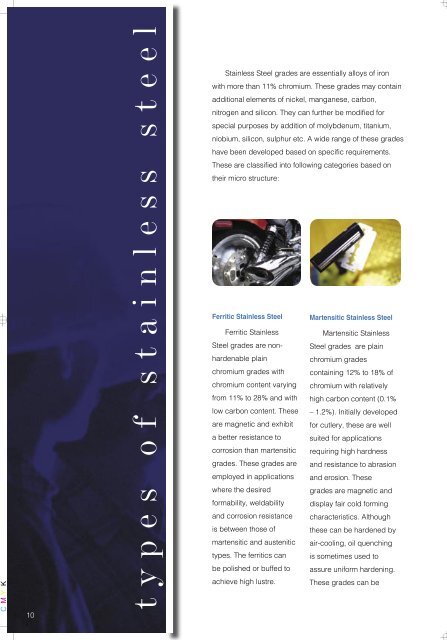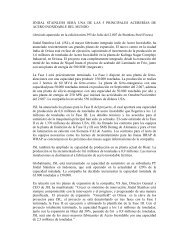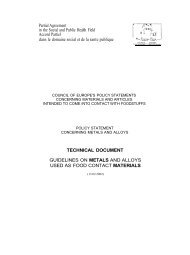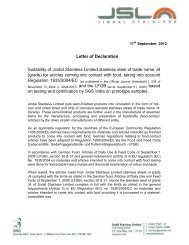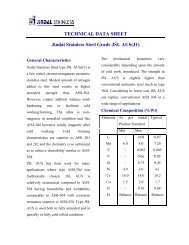Jindal Stainless - Gual Steel
Jindal Stainless - Gual Steel
Jindal Stainless - Gual Steel
Create successful ePaper yourself
Turn your PDF publications into a flip-book with our unique Google optimized e-Paper software.
10<br />
t y p e s o f s t a i n l e s s s t e e l<br />
<strong>Stainless</strong> <strong>Steel</strong> grades are essentially alloys of iron<br />
with more than 11% chromium. These grades may contain<br />
additional elements of nickel, manganese, carbon,<br />
nitrogen and silicon. They can further be modified for<br />
special purposes by addition of molybdenum, titanium,<br />
niobium, silicon, sulphur etc. A wide range of these grades<br />
have been developed based on specific requirements.<br />
These are classified into following categories based on<br />
their micro structure:<br />
Ferritic <strong>Stainless</strong> <strong>Steel</strong> Martensitic <strong>Stainless</strong> <strong>Steel</strong><br />
Ferritic <strong>Stainless</strong><br />
Martensitic <strong>Stainless</strong><br />
<strong>Steel</strong> grades are nonhardenable<br />
plain<br />
chromium grades<br />
<strong>Steel</strong> grades are plain<br />
chromium grades with containing 12% to 18% of<br />
chromium content varying chromium with relatively<br />
from 11% to 28% and with high carbon content (0.1%<br />
low carbon content. These – 1.2%). Initially developed<br />
are magnetic and exhibit for cutlery, these are well<br />
a better resistance to suited for applications<br />
corrosion than martensitic requiring high hardness<br />
grades. These grades are and resistance to abrasion<br />
employed in applications and erosion. These<br />
where the desired<br />
grades are magnetic and<br />
formability, weldability display fair cold forming<br />
and corrosion resistance characteristics. Although<br />
is between those of these can be hardened by<br />
martensitic and austenitic air-cooling, oil quenching<br />
types. The ferritics can is sometimes used to<br />
be polished or buffed to assure uniform hardening.<br />
achieve high lustre. These grades can be


